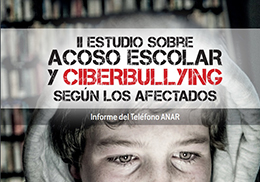
During the last year, there has been a huge increase in the visibility of the bullying situations and the number of people who is informed of this circumstances has increased. In particular, psychologists are the most mentioned professionals, behind the directors and the head teachers of the educational centres, since the requests have increased more than 10% in a year.
10 july 2017
The ANAR Foundation (Ayuda a Niños y Adolescentes en Riesgo) affirms so in the new Study about bullying and cyberbullying according to the victims, elaborated jointly with the Mutua Madrileña Foundation, with the objective of fighting against this problem that affect a growing number of children and teenagers.
The purpose of this 2nd edition is to know the evolution of bullying and cyberbullying among the victims, as well as the changes that took place in their environment during the last year. In order to do so, the results of the first report (with data between 2013 and 2015) have been compared with the numbers obtained this year 2016 by considering concurrently the social context of attitude change, which has been encouraged mostly by the awareness campaigns implemented in recent years.
Then we present the main conclusions of the study:
An increase in the phone calls
While in 2015, a total of 23.230 phone calls related to bullying were taken, in 2016, the number of calls has amounted to 52.966, which means a substantial increase. In the cases of cyberbullying, it stands out the increase in the phone calls of adults requesting attention in comparison with the ones of children and/ or teenagers (74.7% compared with 28.9%).
Greater support to victims
According to the obtained data, the authors point out a greater support to victims on the part of their peers –friends or schoolmates–. Whereas, until the year 2015, in only 22.8% of cases, there had been some reaction from friends and schoolmates, currently, they represent more than half (51.8%), a number that is detected In cases of bullying, which rises in situations of cyberbullying, reaching a percentage of 68.3%.
Greater visibility to bullying situations
On another level, there are a greater communication and visibility of the bullying situations by informing an increasing number of people about this situations in the 95.2% of cases. These people come from the school environment. The psychologists are the second professionals mentioned, behind the directors and the head teachers of the educational centres.
Although the authors specify that only a part of the psychologists mentioned belong to the educational centres, it is echoed by the exponential increase in the number of consultations to these professionals, moving, in only one year, from 2,6% to 39,9% in situations of bullying, and from 2.8% to 33.3% in cases of cyberbullying.
Greater perception of bullying
There is an increase in the perception of bullying, which leads to taking measures in schools -although they are still not enough-, representing a greater control of bullying in classrooms, which is transferred to places of leisure and during the rest time between classes.
As a consequence, teacher assessments have improved, although negative grades are still common (53.3% of bullying cases).
Increase in the violence
Violence remains prevalent, even with slight increases in the last year. Even though the more common forms are insults of offensive words (71.1% of the cases), the ‘hard’ physical abuse remains very usual: blows and kicks (51.5%), isolation (29.7%), shoves (22.6%), threats (22.2%) and theft or object’s breaking (14.7%).
The percentage if psychological problems remains very high (more than 90% of the victims suffer from them). Children especially suffer sadness, anxiety and fear. Secondly, there is isolation, loneliness, differences among classmates, low self-esteem and aggressiveness or anger. Finally, there are also problems linked to efficiency and social skills.
However, despite the important presence of psychological problems and the increase of cases in which the psychologist is informed abbot the bullying situations, only the 18% of victims received psychological care during 2016, which is a slightly higher number than the one of previous years. This procedure was only performed in the 17.5% victims of Cyberbullying.
The authors also underline the seriousness of the fact that this psychological problems have also reached the family. In this case, the same consequences of the victims (anxiety, fear, sadness) are increased).
Cyberbullying
The report pays special attention to this kind of bullying since it entails a greater seriousness than the ‘traditional’ bullying. According to the authors, even though its evolution and frequency have slightly improved in 2016, the seriousness of cyberbullying remains worrying.










